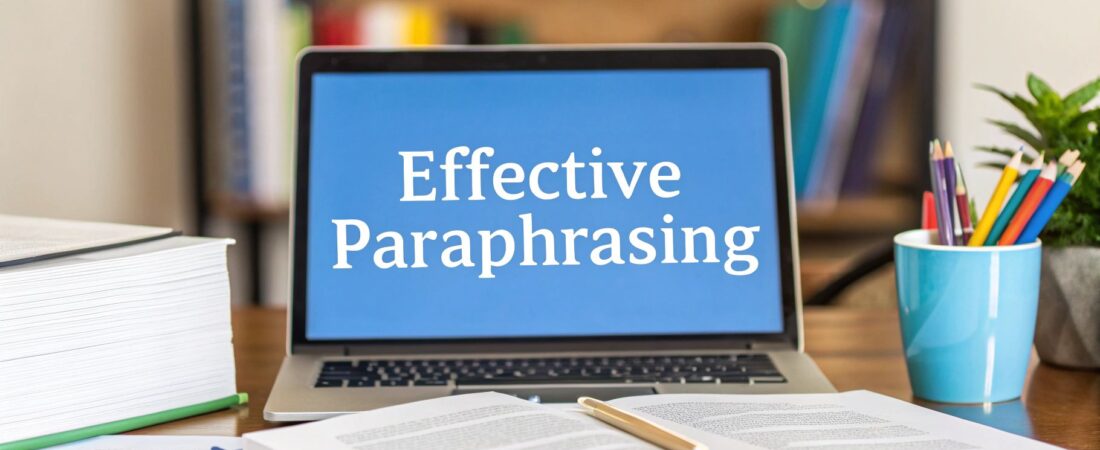Breaking Down the Art of Effective Paraphrasing

Good paraphrasing involves much more than just finding different words to say the same thing. To paraphrase well, you need to fully understand the original message and rewrite it in your own voice. Many writers make the mistake of focusing too narrowly on swapping out individual words, which often results in stilted writing that borders on plagiarism. For instance, simply replacing the word "happy" with "joyful" doesn't truly rework the content in a meaningful way.
Understanding the Cognitive Process
Strong writers take a systematic approach to paraphrasing. First, they read the text carefully to grasp the main ideas and supporting points. This process mirrors how we naturally explain complex topics to others – we don't just repeat what we heard word-for-word, but rather process the information and express it in our own way. Writers also consider who they're writing for and adjust their word choice and tone accordingly.
Practical Approaches to Effective Paraphrasing
Several proven techniques can help improve your paraphrasing skills. One method is to restructure sentences – for example, breaking a long complex sentence into two shorter ones or combining simple sentences into a more complex form. You can also shift perspective or change between active and passive voice. For instance, "The cat chased the mouse" becomes "The mouse was chased by the cat." These changes maintain the core meaning while creating original text.
Comparing Effective and Ineffective Techniques
The following table shows the contrast between good and poor paraphrasing approaches:
| Original Text | Ineffective Paraphrase | Effective Paraphrase |
|---|---|---|
| The dog barked loudly at the mail carrier. | The canine barked clamorously at the postal worker. | The mail carrier was greeted by the dog's loud barks. |
| The heavy rain caused flooding in the city. | The substantial precipitation resulted in inundation. | Due to the heavy rain, the city experienced flooding. |
As these examples demonstrate, effective paraphrasing means rewriting content in your own words while keeping the original meaning intact. This approach helps you smoothly integrate source material into your writing while avoiding plagiarism. By mastering these paraphrasing skills, you'll become a stronger writer and communicator.
Transforming Complex Ideas Into Your Own Words
Good paraphrasing requires more than just swapping words for synonyms. It calls for a deep grasp of the source material and the skill to rebuild its meaning through your own unique expression. Strong writers achieve this by using multiple techniques together to create natural, authentic rewording that captures the original meaning while sounding fresh and original.
Combining Transformation Strategies for Natural Paraphrases
One key approach is to restructure sentences in different ways. This might mean breaking down complex sentences into simpler parts. For instance, instead of "The intricate and multifaceted nature of quantum physics often presents significant challenges for novice learners," you could write "Quantum physics is complex. This makes it difficult for beginners." You can also combine shorter sentences into longer ones to add variety to your writing.
Changing perspective offers another way to present information differently while keeping the core message. Rather than writing "I conducted a study on the effects of caffeine," you might say "A study explored the effects of caffeine." This small shift maintains the key information while offering a new angle.
Switching between active and passive voice provides another useful tool. As noted earlier, changing "The cat chased the mouse" to "The mouse was chased by the cat" gives the sentence a different structure without losing its basic meaning. When you blend these different methods – restructuring sentences, shifting perspective, and changing voice – you create paraphrasing that accurately reflects the source while standing as your own work.
Applying These Techniques to Different Types of Content
The best paraphrasing approach depends on what type of content you're working with. For theoretical concepts, you often need to break down complex ideas into simpler explanations, similar to translating difficult concepts into more accessible language. This might mean taking a dense philosophical argument and presenting its main points in everyday terms.
When working with research findings, accuracy becomes especially important. Statistical information needs careful rewording that preserves the exact meaning. For more on this topic, see How to master paraphrasing statistical data. While changing "57% of participants preferred option A" to "Over half of the participants favored option A" works when exact numbers aren't crucial, keep the original figures when precision matters.
By mastering these various techniques, you can effectively present others' ideas while maintaining your own voice. Regular practice helps develop better paraphrasing skills, leading to stronger writing that both honors source material and expresses ideas originally. This skill proves valuable across all academic fields and types of writing.
Mastering Statistical and Technical Content

Writing about technical and statistical information requires skill and precision. The goal is not just to rephrase data but to present it in a clear, meaningful way that advances your argument. For example, instead of simply restating that "62% of participants experienced improved performance after implementing Strategy A," you might write "Strategy A led to better performance for nearly two-thirds of study participants." This approach maintains accuracy while making the information more digestible for readers.
Presenting Data Points Clearly and Cohesively
When dealing with multiple statistics, focus on telling the story behind the numbers. Take this example: Rather than listing "25% preferred Feature X, 35% preferred Feature Y, and 40% preferred Feature Z," highlight the meaningful patterns: "Users showed a clear preference hierarchy, with Feature Z emerging as the top choice, followed by Feature Y, while Feature X attracted the smallest user base." This approach helps readers grasp the bigger picture and understand how different data points relate to each other.
Maintaining Precision While Simplifying Complexity
Making technical concepts accessible doesn't mean sacrificing accuracy. One effective technique is using real-world comparisons – for instance, explaining a complex sorting algorithm by comparing it to organizing books on a shelf. Visual elements like charts and graphs can also clarify complex information better than text alone. The key is finding ways to make technical content more approachable while preserving its essential meaning.
Avoiding Common Pitfalls
Several mistakes can weaken technical writing. Simply swapping in synonyms often creates awkward phrasing that clouds meaning. Keeping too much of the original text structure can border on plagiarism. Perhaps most importantly, oversimplifying statistical findings (like changing "statistically significant increase" to just "increase") can misrepresent the research. Success requires understanding the concepts deeply enough to explain them in your own clear, precise words while keeping all important technical distinctions intact.
Navigating Common Paraphrasing Challenges

Even skilled writers face difficulties with paraphrasing at times. Let's explore some common challenges and practical ways to overcome them. From overusing synonyms to dealing with technical terms, understanding these hurdles helps us create better, more original content that stays true to the source material.
Over-Reliance on Thesaurus Substitutions
Simply swapping words with synonyms is a common mistake that often leads to awkward writing. For instance, changing "The cat sat on the mat" to "The feline reclined upon the rug" uses synonyms but sounds forced and unnatural. Good paraphrasing requires more than just finding different words – it needs a clear understanding of the main ideas and the ability to express them naturally. This relates to another frequent issue: keeping too much of the original structure.
Maintaining Original Sentence Structure
Many writers stick too closely to the source text's sentence patterns. Even with different word choices, keeping the same structure can still count as plagiarism. For example, changing "The heavy rain caused flooding in the city" to "The intense precipitation resulted in inundation of the urban area" follows the original too closely. A better approach would be reworking it completely: "The city experienced widespread flooding due to the heavy rain." This creates a more natural flow while preserving the key message.
Handling Technical Terminology and Complex Concepts
Working with specialized terms and complex ideas presents special challenges. While some technical terms have no good substitutes, oversimplifying can change the meaning. Take a scientific paper – changing "a statistically significant increase" to just "an increase" removes important context about the findings. One solution is to briefly explain technical terms in simpler language. Rather than just writing "The algorithm uses a recursive function," you could say "The algorithm uses a function that repeats itself, a process known as recursion, to efficiently solve the problem." This keeps the meaning clear while making it more accessible.
Practical Solutions For Common Paraphrasing Emergencies
When you hit a paraphrasing roadblock, try these practical steps: First, take a short break from the source material to clear your mind. Next, explain the concept out loud as if telling it to someone else – this helps you find your own way of expressing it. Finally, combine different techniques – restructure sentences, shift perspective, use carefully chosen synonyms, and add brief explanations of complex terms when needed. This varied approach leads to paraphrases that accurately capture the original while adding your own voice to the discussion.
Building Your Academic Voice Through Paraphrasing
Creating a unique academic voice means far more than just avoiding plagiarism. Skillful writers use paraphrasing as a way to build robust arguments while seamlessly weaving in ideas from other sources. This involves thoughtfully rephrasing content to align with your own perspective and writing style.
Strengthening Arguments Through Source Integration
When you paraphrase effectively, you can present evidence that reinforces your key points. For instance, if you're making a case that exercise enhances brain function, instead of directly quoting research, you might write: "Research indicates that physical activity can enhance memory and attention span." This approach lets you incorporate supporting evidence while maintaining your own voice. Drawing from multiple sources also demonstrates your thorough grasp of the topic, similar to how a lawyer builds a case with various pieces of evidence.
Maintaining Authenticity While Incorporating Other's Ideas
One key challenge is blending outside sources with your distinct writing voice. This requires expressing complex concepts in language that feels natural to you, without oversimplifying the core ideas. Learn more in our article about How to master grammar. Think of it like translating between languages – your goal is to convey the same meaning while using different words that fit your style.
Handling Conflicting Viewpoints and Building Stronger Arguments
Skilled paraphrasing helps you address opposing perspectives with care and nuance. When you accurately represent contrasting views in your own words, you can better analyze their merits and limitations. This allows you to construct more compelling arguments by directly engaging with counterpoints and showing deep understanding. You might paraphrase an opposing stance and then provide a thoughtful rebuttal that demonstrates your critical thinking.
Weaving Paraphrased Material Seamlessly into Your Writing
Picture creating a tapestry where different threads come together in a unified design. Similarly, effective paraphrasing means smoothly integrating borrowed material into your writing. Pay attention to sentence structure, word choice, and flow. Rather than awkwardly inserting paraphrased content, use natural transitions to connect outside information with your ideas. This creates coherent writing where paraphrased material enhances your argument instead of disrupting it. By mastering these techniques, you'll develop a more authoritative academic voice while properly attributing others' work.
Practical Implementation and Skill Development

Let's move beyond theory and focus on building real paraphrasing skills through hands-on practice. Just like learning any new skill, becoming better at paraphrasing requires consistent practice and a structured approach to improvement. This section will walk you through practical exercises and methods to strengthen your paraphrasing abilities.
Evaluating Your Paraphrasing Effectiveness
Good paraphrasing follows three key principles: accuracy, originality, and clarity. When evaluating your work, start by checking if you've maintained the original meaning without distortion – this is the accuracy component. Next, examine if you've truly expressed the idea in your own words rather than just swapping out synonyms. Finally, make sure your paraphrased text reads smoothly and makes sense to your audience. For instance, when paraphrasing complex technical content, focus on explaining the concepts in clear, accessible language while preserving the essential technical details.
Developing a Reliable Quality-Check Process
Make these steps part of your regular writing routine to ensure high-quality paraphrasing:
- Compare: Review your paraphrase against the source text to verify all key information is accurately captured
- Analyze: Check your word choices and sentence structures – have you rewritten the ideas in a genuinely new way?
- Read Aloud: Speaking your paraphrase helps identify awkward phrasing and unclear sections that need revision
- Seek Feedback: Ask others to review your work and provide input on clarity and originality
Following these checkpoints helps maintain consistent quality in your paraphrasing. With practice, this process becomes second nature and speeds up your writing workflow.
Measuring Your Improvement: Concrete Benchmarks and Self-Assessment
Track your progress using specific benchmarks and assessment tools. You might be interested in: How to master grammar. Pay attention to how often you need to revise your paraphrases – fewer revisions typically show growing skill. Also note feedback from readers and instructors, as positive responses indicate better clarity and originality. Create a simple checklist based on effective paraphrasing principles to evaluate your work. Just as musicians practice regularly to improve, consistent work with these assessment tools will sharpen your paraphrasing abilities. With focused practice and a systematic approach, you can turn paraphrasing from a challenge into a strength. Students can find helpful writing tools at SmartStudi to support their skill development.
